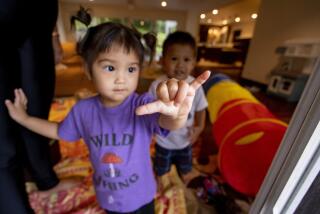CULTURAL FAIR : Hawaiian troupes will show how the <i> real</i> hula is done.
- Share via
Think of the hula dance.
Whatever you’re thinking, you’ve probably got it all wrong unless you happen to be a native Polynesian Hawaiian.
Spend some time with Sharon Paulo or Clarice Nuhi, two leaders in the South Bay’s native Hawaiian community organizing a cultural fair for Saturday, and this becomes abundantly clear.
“The thing you see on TV is really not true culturally,” said Paulo, who is leading an effort to get a community center built in Carson for the large native Hawaiian population. “It’s not something you do in Las Vegas or Hollywood. It is a very specific way of communicating. It is a respectful art, not somebody just up there moving around.”
If Paulo sounds a little frustrated, it’s because she thinks that native Hawaiians get shortchanged in this country in lots of ways, not just with the misconception of the hula.
But she and other community leaders have hatched an idea they think may help set the record straight on native Hawaiians: They will sponsor a cultural fair Saturday at the Carson Community Center, 801 E. Carson St., featuring a host of authentic hula dancing troupes, arts and crafts.
General admission is $15.
Members of the Hawaiian Community Center Assn., of which Paulo is president, hope the fair becomes an annual event that will help educate non-Pacific Islanders about Hawaiian culture and traditions, and raise money for a community center.
There are about 34,500 Hawaiians living in California, with about 8,000 in Los Angeles County, according to the 1990 U.S. Census. In L.A., a majority of Hawaiians live in the South Bay, primarily in Carson and Gardena.
Paulo said Hawaiians came over in droves in the early 1960s to work in aerospace manufacturing and other industries. And although the numbers are small, the community has been growing. The Los Angeles population increased 29% over the last decade, and the California population increased 49%.
Despite its sizable population, the community lacks a central meeting place. Leaders hope to raise $6 million over the next three to five years to build a community center.
Fund-raisers such as concerts and other cultural fairs are being organized, and Paulo plans to apply for government grants.
“The community center is very important,” said Sissy Kaio, who has run a Carson hula studio for 13 years. “We have been around a long time and a lot of other groups already have a center.”
Hawaiian leaders also hope the center will enable them to better promote their culture, which was dominated by European, and later American, settlers on the island in the 18th and 19th centuries.
“When white people came, all of sudden we were heathens,” Nuhi said.
The fair will include dedications to Hawaii’s last king, David Kalakaua, nicknamed the Merry Monarch. Kalakaua is credited with reviving interest in the hula, Hawaiian music and other ancient customs that Christian missionaries had suppressed. He also urged native Hawaiians to marry within the culture, believing that native islanders were being killed off by European and American diseases and intermarriage.
Six hula clubs, called halaus , will demonstrate how different the dance is from the way it has been portrayed on TV and in movies.
“The ancient hula is more spiritual and involves a lot more training than hulas you see on TV,” said Kaio, whose halau will perform at the fair.
Authentic hulas, Kaio said, are performed with ipu heke , a percussion instrument made from a double-head gourd, and pahu , a drum made from coconut bark and shark skin.
A hoopua , or chanter, calls out chants that form stories or poems, some of which originated centuries ago.
The whole purpose of the dance is to tell a story or poem, sometimes rather ribald (these often were suppressed by Christian missionaries).
“The poetry of the song is more important than the hula itself,” Kaio said. “You can’t have a hula without it.”
More to Read
The biggest entertainment stories
Get our big stories about Hollywood, film, television, music, arts, culture and more right in your inbox as soon as they publish.
You may occasionally receive promotional content from the Los Angeles Times.










